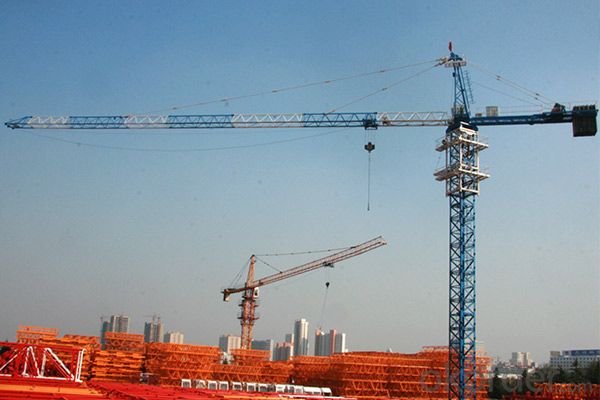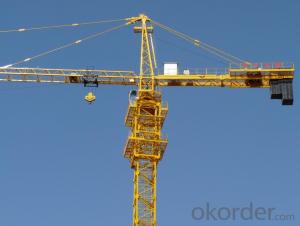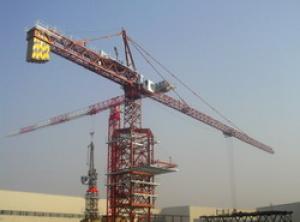QTZ80 (6020) tower crane
- Loading Port:
- Qingdao
- Payment Terms:
- TT OR LC
- Min Order Qty:
- 1 set
- Supply Capability:
- 12 set/month
OKorder Service Pledge
OKorder Financial Service
You Might Also Like
QTZ80(6020) tower crane tower crane is novel hoisting and conveying machinery which is designed by fully utilizing the group technology, the combinational design technology and the finite element analysis technology and taking the tower crane microcomputer design platform as a tool.
The crane is a horizontal-arm-rest trolley-amplitude upper-revolution hydraulic lifting type crane which has the maximum working amplitude of 56m, the independent lifting height of 40m, the adhesion lifting height of 150m, the rated lifting moment of 710kN•m and the maximum lifting moment of 853.2kN•m. All the performance parameters and technical indexes of the crane meet or surpass national standards.
The crane features advanced parameters, excellent and reliable properties, attractive appearance, high quality, simple and practical structures, advanced safety devices, convenient maintenance, safe usage and reasonable prices, and is ideal construction machinery for many construction enterprises.
The lifting boom and balance boom adopt cantilever boom structure, which reduces the hoisting modular and makes it more safe, convenient and flexible to install and uninstall, and reduces the requirements for hoisting equipment and the site.
2. Multiple special mounting brackets are available, which saves the installation time and ensures safe and quality installation.
3. The lifting boom adopts cantilever boom structure and variable cross-section materials, featuring more reasonable structural stress and long service life; and it is easier to make different combination of boom length.
| Amplitude(m) | 3-13.6 | 14 | 15 | 16 | 17 | 18 | 19 | 20 | 21 | 22 | 23 |
Lifting capacity(kg) | 4000 | 3890 | 3618 | 3380 | 3170 | 2860 | 2810 | 2660 | 2530 | 2400 | 2290 |
Amplitude(m) | 24 | 25 | 26 | 27 | 28 | 29 | 30 | 31 | 32 | 33 | 34 |
Lifting capacity(kg) | 2190 | 2090 | 2000 | 1920 | 1850 | 1770 | 1710 | 1650 | 1590 | 1540 | 1490 |
Amplitude(m) | 35 | 36 | 37 | 38 | 39 | 40 | 41 | 42 | 43 | 44 | 45 |
Lifting capacity(kg) | 1440 | 1390 | 1350 | 1310 | 1270 | 1230 | 1200 | 1170 | 1130 | 1100 | 1070 |
Amplitude(m) | 46 | 47 | 48 | ||||||||
Lifting capacity(kg) | 1050 | 1020 | 1000 |
(2)2-magnification Lifting Performance Table
Amplitude(m) | 3-26 | 27 | 28 | 29 | 30 | 31 | 32 | 33 | 34 | 35 |
Lifting capacity(kg) | 2000 | 1920 | 1850 | 1770 | 1710 | 1650 | 1590 | 1540 | 1490 | 1440 |
Amplitude(m) | 36 | 37 | 38 | 39 | 40 | 41 | 42 | 43 | 44 | 45 |
Lifting capacity(kg) | 1390 | 1350 | 1310 | 1270 | 1230 | 1200 | 1170 | 1130 | 1100 | 1070 |
Amplitude(m) | 46 | 47 | 48 | |||||||
Lifting capacity(kg) | 1050 | 1020 | 1000 |
Technical Performance Parameter Table
Item | Unit | Magnification | ||
α=2 | α=4 | |||
Rated lifting moment | kN.m | 500 | ||
Maximum lifting capacity | t | 2 | 4 | |
Working amplitude | m | 3 ~48 | ||
Maximum amplitude lifting capacity | t | 1.0 | ||
Lifting height | Independent | m | 30 | |
Attached | m | 120 | ||
Time of moving outrigger end to rotation center | m | 48.74 | ||
Time of moving balance arm tail to rotation center | m | 12.816 | ||
Counter weight | t | 7 | ||
Total motor power | kW | 24.9 | ||
Allowable working temperature | 0C | -20~+40 | ||
- Q: Who do you think would win in a battle between Roger Thorpe and Alistair Crane?
- HI! I didn't know there was another character named Roger Thorpe. I remember a character named Roger Thorpe on the Guiding Light years ago.
- Q: we using EOT crane my company
- Your okorder /... contact them with your enquiry. You must include Model and anticipated loads as that determines torque applied. Seed is operator dependent for safe operation.
- Q: What are the special operators of tower cranes?
- The tower has special operations personnel of heavy machinery refers to the construction site in the tower crane division signal cable, installation and disassembly, the driver, and the demolition work of gondola installation, may cause serious harm to themselves, others and the surrounding facilities operations personnel. Specific include construction lifting signal division, cable construction, lifting machinery, tower crane driver (T), construction crane, tower crane installation, demolition worker (T), and height job basket, installation, demolition workers.
- Q: From what I'm understanding in the first stanza, a women lost her lover to the war because he fell off his horse...Is that right?
- Yes, Stephen Crane talks about lost love and sacrifices in his poem. The basic casualty of war. A lover, a father and son are lost in his story and those that are left behind he tries to console. The poem is noted for the ironic use of war is kind. We all know that War is really not kind. The poem’s speaker, simultaneously sympathetic with the victims of war and cynical about the purposes of war, implicitly criticizes the image of the romantic hero, showing in graphic scenes the realities of battlefield death and the emotional torment it causes for those left behind.
- Q: What does a track type tower crane look like? In that case, use?
- The rail type multi characteristic tower crane consists of track, door frame, main arm, auxiliary arm, hook and so on. Its features are: A, crane through the door frame (2), supported on a track (1); B, the door frame (2) is provided with a rotary bearing (3); C (3) is arranged on the rotary supporting all kinds of machinery and equipment (4), and balance weight (8); D, the main arm (5) the jib (6) through the bearing cable (7) is installed on the rotary support (3); E, the main arm (5) side arm (6) and Russo (7) can have a variety of length combination; F, a main arm, jib all tube truss structure; G, hook pulley h, equipped with a variety of rate; the torque limiter (10) and amplitude detection device (11); I, operating room in slewing bearing (3); J, self moving use winch is luffing winch main arm, mounted on a rotary support (3).Track type multi characteristic tower crane. The utility model is especially suitable for power construction and hoisting operation. The slewing support on the track type door frame is provided with a main and an auxiliary arm frame, and various variants can be formed through different combinations. Its maximum torque of 3360 tons meters, the maximum lifting capacity of 140 tons, the maximum working range of 60 meters, the maximum rise of 120 meters. The utility model can be carried in the lifting, and the work is smooth and safe. The main and auxiliary arms are all truss structures, light in weight. The electronic torque limiter and other safety devices are adopted, and the 130 meter high machine can be installed by itself. This machine can also be used in petroleum, chemical, metallurgical and other large projects.
- Q: What are the main parameters of a tower crane?
- For car luffing tower cranes, the maximum lifting height is only related to the height of the tower, and when the height of the tower is determined, the maximum height of the ceiling is a certain value.In addition to the 4 major performance parameters. And the working speed (including lifting speed, rotary speed and walking speed of car, traction speed), an important parameter gauge, wheelbase, total power, motor structure weight, balance and gross weight, etc.. These important parameters often determine the tower crane selection, such as speed of operation often determines the number of selected cranes, motor power requirements of power supply load, gauge, wheelbase of the site, and the structure weight, balance weight, weight of the foundation treatment of heavy machine requirement.Tower crane (tower crane) is called tower crane, also known as tower crane. A revolving crane mounted on top of a tall tower. The working space is large, mainly used for the vertical and horizontal transportation of materials and the installation of building components during the building construction. The tower crane consists of three parts: metal structure, working mechanism and electrical system. The metal structure includes the tower, the boom and the base. The working mechanism has four parts, lifting, luffing, turning and walking. The electrical system consists of motors, controllers, power distribution cabinets, connecting lines, signals and lighting devices, etc..
- Q: In Batman Begins, what was Dr. Crane/ Scarecrow (Cillian Murphy) after? What did he get in return with working with them and why did he work with them? He doesn't strike me as the kind to work with groups, he seems like a guy who rather work alone.
- Dr. Johnathan Crane is a brilliant scientist who specializes in the study of fear. In return for his work Dr. Crane received funds and more important the blue flowers needed to produce the fear gas drug.
- Q: If any of you have read The Red Badge of courage by Stephen Crane can you please tell me what you think about it. Is it a good book or is it not?!!!! Do you praise it or critize it !? i need your opinion what's your review! Thanks
- The okorder /
- Q: I have some cranes in our field next door and I was wondering do they eat chickens? I live in Wisconsin.?
- Cranes wouldn't try to eat a full grown chicken. Although they can eat cooked chicken it is safe for them and they love it. Cranes may be aggressive with younger chicks but won't eat them. Hope this helped!
- Q: What were Henry's reasons for becoming a soldier? What about the war was so attractive to him?Why do you think it took Henry so long to begin contemplating his part in battle?How do Jim and Wilson respond to Henry's question? What does this tell you about them?Share your thoughts...
- Henry begins the book as an idealistic and completely self-absorbed teenager who wants nothing more than a chance to show off and be thought of as a brave and daring male. From Shmoop
Send your message to us
QTZ80 (6020) tower crane
- Loading Port:
- Qingdao
- Payment Terms:
- TT OR LC
- Min Order Qty:
- 1 set
- Supply Capability:
- 12 set/month
OKorder Service Pledge
OKorder Financial Service
Similar products
Hot products
Hot Searches
Related keywords


























